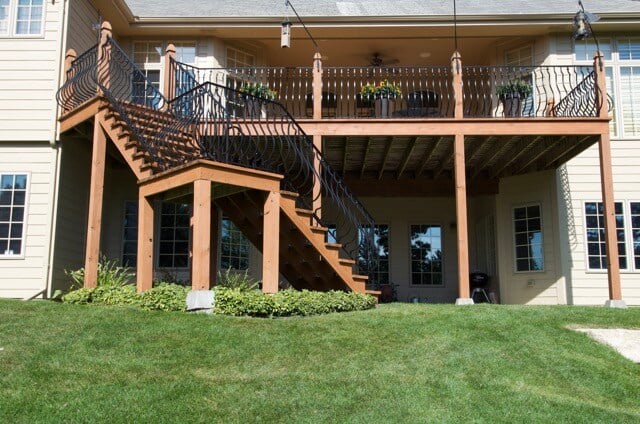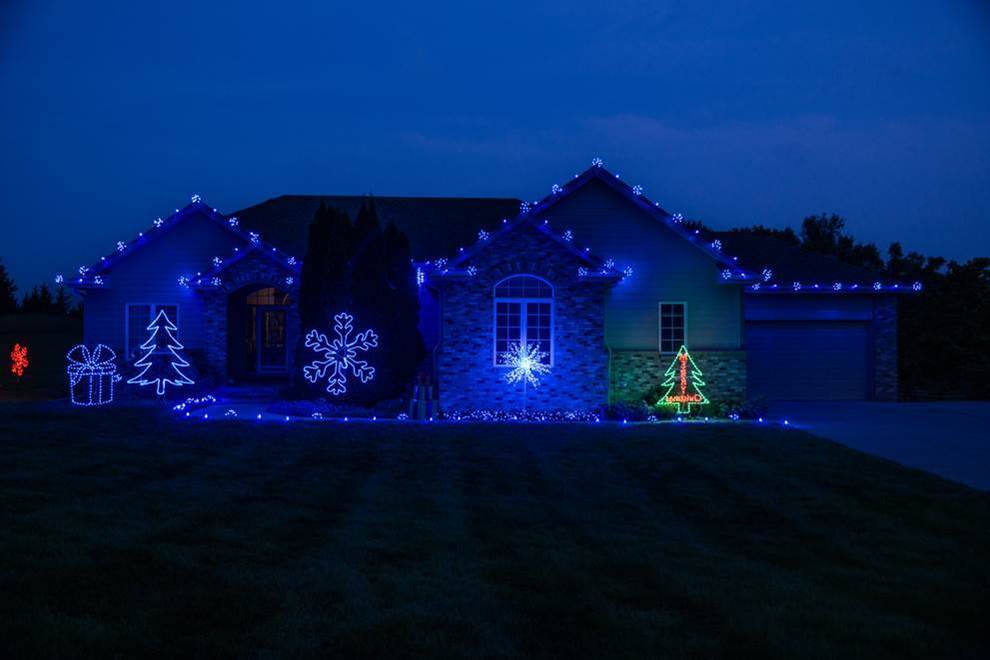9 Mistakes To Avoid When Deck Staining in Omaha
October 11th, 2024
5 min read

Picture this: You step out onto your deck, ready to enjoy a sunny afternoon, but all you see are peeling paint, faded wood, and a surface that looks like it’s seen better days. Sound familiar? A poorly maintained deck not only ruins the aesthetics of your outdoor space but can also lead to more serious issues like wood rot and structural damage.
At Brush & Roll Painting, we’ve seen it all when it comes to deck disasters. We’ve been professionally staining decks since 1996. From decks that were previously stained in the bad weather to those where the prep work was entirely skipped, we’ve helped countless Omaha homeowners rescue their outdoor wooden spaces. We know what works and, more importantly, what doesn’t.
In this article, we’re going to walk you through the most common mistakes people make when staining or painting their wooden decks. By reading this article, you will know how to avoid these pitfalls so you can enjoy a deck that looks great and lasts longer.
This article isn’t just for DIY homeowners who want to stain their deck themselves, some of these mistakes are made by inexperienced painters in Omaha. So it’s important while you are hiring a painter, that you know the correct steps to make sure your job gets done correctly. There’s nothing worse than a wasted investment in your home!
Mistake #1: Skipping the Prep Work Before Deck Staining
One of the biggest mistakes homeowners make is diving straight into staining or painting without preparing the deck first. This step might seem repetitive and overhyped, but it’s essential. Neglecting to clean the deck properly or skipping sanding can lead to uneven application and a finish that won’t last.
How to Avoid It: Start by thoroughly cleaning your deck to remove dirt, grime, and any old paint or stain. Then, repair any damaged boards, cracks, and popped nails or screws. Next, sand the surface to create a smooth base for the new finish. This step ensures that the stain or paint adheres properly and lasts longer.
Mistake #2: Using the Wrong Type of Wooden Deck Paint or Stain
Not all paints and stains are created equal. Using the wrong type can lead to peeling, fading, or a finish that doesn’t protect your deck from the elements.
How to Avoid It: Choose a product specifically designed for outdoor wood surfaces. Consider the climate in Omaha—opt for a stain or paint that can withstand extreme temperatures and humidity.
There are also four types of stains for decks. 1. a transparent stain (toner), 2. a semi-transparent stain, 3. a semi-solid stain, or 4. a solid deck stain. Learn more about which type of deck stain is right for your deck.

Mistake #3: Ignoring Weather Conditions While Deck Staining
Weather plays a huge role in the success of your deck staining or painting project. Too hot, too cold, or too humid, and you could be setting yourself up for failure.
How to Avoid It: Check the weather forecast before you start. The ideal conditions are dry weather with temperatures between 50°F and 85°F. Avoid staining or painting in direct sunlight or just before it rains.
Mistake #4: Applying Too Much or Too Little Product
More isn’t always better. Applying too much stain or paint can lead to a sticky, uneven finish, while too little can result in poor coverage and protection.
How to Avoid It: Follow the manufacturer’s instructions regarding application thickness. Use a brush or roller to apply the product evenly and avoid going back over areas that have already started to dry.
Mistake #5: Rushing the Drying Time on Your Deck
Patience is key when it comes to deck maintenance. Rushing the drying process can ruin all your hard work, leaving you with a tacky finish that won’t hold up.
How to Avoid It: Allow ample time for each coat to dry thoroughly before applying the next. Depending on the product and weather conditions, this could take anywhere from a few hours to a full day.
Mistake #6: Not Considering Deck Material
Not all decks are made from the same type of wood, and treating them all the same can lead to issues down the line. Different materials require different care.
How to Avoid It: Identify the type of wood your deck is made from—whether it’s pressure-treated lumber, redwood, or cedar—and choose your products accordingly. Some woods, like cedar, are more porous and might require a special type of stain.
It’s also crucial to remember that wood has groves, grain, and natural imperfections. So as the stain is applied, it should be brushed into the grain in all directions. This ensures an even, full coat of product, to settle into the wood.
-Oct-02-2024-07-31-12-5371-PM.png?width=628&height=328&name=Blog%20Post%20Image%20Size%20(8)-Oct-02-2024-07-31-12-5371-PM.png)
Mistake #7: Using Poor Quality Brushes and Rollers
The tools you use can make or break your project. Cheap brushes and rollers often leave behind streaks, bristles, and lint, ruining the finish. Low-quality brushes may only last for a few home projects.
How to Avoid It: Invest in high-quality brushes and rollers designed for deck work. A good brush will ensure even coverage and a smoother finish, while a quality roller will help you cover larger areas quickly. High-quality brushes and rollers will also last longer, so you don’t have to keep repurchasing them each time you want to do a DIY painting project.
Mistake #8: Not Sanding the Deck Before Staining
One of the more nuanced steps in deck preparation, which is often overlooked by DIY homeowners and many painters, is sanding the deck before applying stain.
While this step might seem unnecessary and time-consuming, especially if the deck looks relatively smooth, skipping it can lead to a less-than-ideal finish that only professional painting companies know how to avoid.
When you stain a deck without sanding it first, you risk the stain not penetrating the wood evenly. This can result in blotchy, uneven coloring and a finish that doesn’t last as long as it should. Sanding helps to open up the wood’s pores, allowing the stain to be absorbed more effectively, which leads to a richer, more even color and a smoother finish.
How to Avoid It: Before staining, use a power sander to lightly sand the entire deck surface. This removes any old stains, dirt, and imperfections, smooths out rough spots, and prepares the wood to absorb the new stain evenly. Professionals know that this step is crucial for achieving a high-quality, long-lasting finish.
While it might add a bit more time and effort to your project, the results are well worth it—giving your deck a polished, professional look that stands up to the elements.
By taking this extra step, you’re ensuring that the stain will adhere properly, providing better protection against weather damage and extending the life of your deck.
-Jul-10-2024-03-48-08-4867-PM.png?width=632&height=330&name=Blog%20Post%20Image%20Size%20(1)-Jul-10-2024-03-48-08-4867-PM.png)
Mistake #9: Forgetting Regular Maintenance After Staining/Painting
Once you’ve finished staining or painting, it’s easy to think the job is done. But regular maintenance is key to keeping your deck looking its best.
How to Avoid It: Plan for regular cleaning and touch-ups to keep your deck in top shape. This might include washing the deck with a gentle cleaner every few months and reapplying a fresh coat of stain or paint every 3-4 years.
Click here to learn how to properly maintain your deck year-round.
Avoiding Mistakes on Your Wooden Deck
Maintaining a wooden deck is no small task, but avoiding these common mistakes can make the process smoother and more successful. By taking the time to prep your deck, choosing the right products, and applying them correctly, you’ll be rewarded with a beautiful outdoor space that stands the test of time.
At Brush & Roll Painting, we understand that your deck is an important part of your home, and we’re here to help guide you through the process of maintaining it. By avoiding these common mistakes, you can enjoy a deck that not only looks stunning but also lasts for years to come.
If you ever need expert advice assistance or want to get a quote for your remember that we're just a call (or button click below!) away—ready to help you make the best decisions for your deck painting projects.
Whether you are doing the project yourself or hiring a professional painter, it’s important that you are confident each step of the way. This will ensure that you don’t make any of these mistakes and risk your investment in your deck.
Click the button below to download your deck staining project checklist. Fill out the quick 3-question form and be on your way to an outdoor environment that you love!
Kaylea is the Brush & Roll Painting Content Manager. Kaylea is a Journalism and Media Communications summa cum laude graduate with a minor in Marketing from the University of Nebraska at Omaha. Kaylea manages the marketing for Brush & Roll Painting.
Topics:
















-Jul-23-2025-02-21-33-5468-PM.png?width=800&height=418&name=Blog%20Post%20Image%20Size%20(2)-Jul-23-2025-02-21-33-5468-PM.png)




-Oct-22-2025-01-39-19-5208-PM.png?width=800&height=418&name=Blog%20Post%20Image%20Size%20(1)-Oct-22-2025-01-39-19-5208-PM.png)





